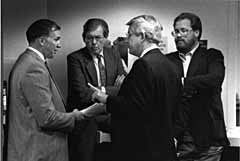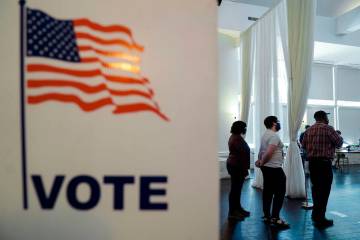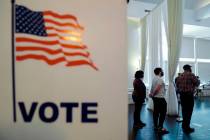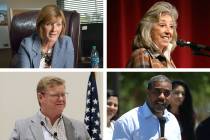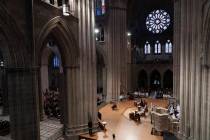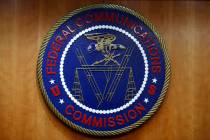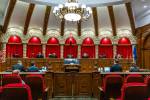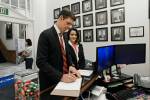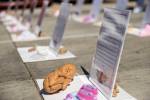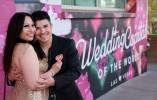Jim Joyce
Consider the role of the garbage can in Nevada politics.
Between 1973 and his death in 1993, Jim Joyce managed campaigns for some 300 candidates, and lost only about 10 percent of them. Having helped elect so many legislators, it is not surprising he was the most effective lobbyist ever seen in the state Capitol. Victorious politicians and fallen rivals thought him a genius. He was certainly imaginative. Which brings us to those garbage cans.
On Election Day, all concerned want to know how voters are leaning. The usual method is to conduct an "exit poll," asking people how they voted. This is expensive. In "The Gentle Giant," Marilee Joyce's literary tribute to her father, former congressman and client James Bilbray explained how Jim Joyce made exit polls affordable.
"Jim had a crew of hearty volunteers make the rounds of key districts, emptying the trash cans outside the polling places," Bilbray wrote. "Jim theorized that many voters make their ballot decisions at home, marking their choices on their sample ballots and taking those ballots with them to the polls to vote. Once those ballots have been cast, the sample ballot goes in the first trash can they see.
"It became known as The Jim Joyce Garbage Can Poll."
Scientific? Hardly. Accurate? Surprisingly so.
Joyce's political acumen and influence was due largely to his natural talent for consensus-building and a reputation for integrity. He was a nice, modest guy people trusted to arbitrate their differences.
"I'm sure a lot of his ability as a facilitator came because people enjoyed the sight of him," recalled Renny Ashleman, his attorney and fellow lobbyist.
He was quite a sight, too. At 6-foot-3, Joyce was always the most visible person in the hallways of the Legislature. Concerned that his height might intimidate people, he deliberately walked slowly, with a stoop, his head and shoulders leading his great gangly frame. His manner was quiet, serious, thoughtful.
James Austin Joyce was born Sept. 23, 1937, in Denver. He and his younger sister, Peggy, were the only children of Austin James Joyce, a Union Pacific Railroad conductor, and Effie Catherine Hart Joyce, a nurse. As a child, Jim Joyce contracted rheumatic fever, and a doctor recommended that the family move to a desert. Las Vegas was the choice.
At Las Vegas High School in the early 1950s, Joyce was managing editor of the campus newspaper, The Desert Breeze, as well as a sports stringer for the Las Vegas Review-Journal.
In 1955, classmate Richard Bryan joined the Breeze staff for his and Joyce's senior year of high school. The future governor and U.S. senator recalled that while the staff "struggled" to put out the paper, Joyce liked the pace.
"Jim was in his element," said Bryan. "Cool and in command, and loving every minute of it."
That year, Bryan went off to the University of Nevada, Reno, and Joyce, his family short of money, stayed in town, and attended classes by the university's new Southern Regional Division, which would become UNLV. A year later, he enrolled at UNR and, like Bryan, he pledged the Alpha Tau Omega fraternity. Bryan described it as a "fateful decision." That's because ATO was the campus "animal house," famed for hard drinking, hearty parties and imaginative mischief, such as goose-hunting from the roof of the frat house. Joyce emerged as a whiz at extricating his brothers from trouble with the Reno cops or the campus administration. Within two years, he was elected ATO president, and had mapped out a campaign that saw Bryan elected student body president.
"It is clear that the negotiating skills that a quarter century later, would earn him universal acclaim as the premier lobbyist in the Nevada Legislature, were being honed during those undergraduate years," Bryan said.
Joyce met his future wife, Nedra Norton, in a UNR journalism class. They married after graduation in 1959, and had two children, Robin and Marilee. Nedra Joyce would make her own mark as a Las Vegas journalist before her death in 1975.
While still in college in 1956, Joyce volunteered to work on the congressional campaign of Democrat Howard Cannon, writing press releases and setting up interviews.
"We didn't win that one," Cannon later said. "But in 1958, with Jim's help, I was elected to the U.S. Senate representing Nevada."
Cannon named the 21-year-old Joyce his press secretary, and the second part of Joyce's political education commenced. In the mid-1960s, he returned to Las Vegas to head Cannon's local office and, in the early 1970s, he joined May Advertising as a political consultant.
During that time, he made his first big splash as a lobbyist in Carson City. Working on his own time, for no pay, he out-lobbied the American Medical Association, and pushed through legislation legalizing Chinese medicine and acupuncture.
In 1975, Joyce and Marydean Martin founded Joyce and Martin Advertising. Their first client was Sunrise Hospital. At the time, Martin noted, hospitals did not advertise. It was regarded as undignified. Sunrise Administrator David Brandsness thought otherwise, and hired Joyce to design a campaign that wouldn't ruffle too many feathers.
Joyce eased into the ad campaign, introducing it in small increments. First, there was a calendar that described a different department of the hospital on each page. A while later, nearly every man woman and child in Southern Nevada was mailed a Sunrise Hospital credit card. Before long, the hospital was advertising free ocean cruises for patients who checked in on weekends.
"Since then, medical advertising has become big business all over the country," said Martin.
Joyce always insisted that he would not champion any candidate or cause he did not believe in himself.
"What set him apart from many was that he would not be a `hired gun,' " said state Sen. William Raggio. He might have drawn that conclusion from watching Joyce deal with a 1981 bill that put a $5 state fee on all marriage licenses, the money to be earmarked for shelters for battered women.
The bill had been introduced in the 1981 Legislature by Sen. Sue Wagner, R-Reno, at the behest of the Committee to Aid Abused Women. Joyce represented the wedding chapel industry, which opposed the fee. Wagner said Joyce listened intently when she made the case for the fee.
"And he agreed that the $5 fee was justified and that the bill should pass," Wagner later recalled. "He promised he would talk to his clients, tell them he personally supported the bill and that they were free to find another lobbyist if they had any problem with the situation." Joyce then threw his weight behind the bill, and it passed easily.
In 1990, Joyce handled Wagner's bid for lieutenant governor. Though she was in a plane crash that left her bedridden between the primary and general elections and made not a single public appearance, Wagner was elected. She credits Joyce.
The Nevada Resort Association in 1987 hatched a cunning scheme designed to head off a gaming tax increase proposed by Sen. Don Mello, D-Sparks. The senator wanted the tax upped from 5.75 percent of the gross win to more than 7 percent. The association's lobbyists huddled with Mello and offered to hold still for a 6.25 percent increase. Mello was amenable. Most of the NRA members were happy.
But Summa Corp., umbrella firm for the late Howard Hughes' casino properties, opposed the increase. Summa's lobbyist was Jim Joyce, who undid the done deal.
Ned Day, political columnist for Las Vegas' Valley Times newspaper, cited a Carson City source who witnessed the entire power play.
"It's the strangest thing you've ever seen," the insider said. "Here you have the presidents of major corporations running around to lawmakers saying, 'Please, please, please raise my taxes.' And you have lawmakers saying, 'Well, I'm not sure that's a good idea.'
"Chalk it up to Jim Joyce," the insider said. "I don't know how he does it."
In 1992, Joyce found himself uncomfortably in the spotlight. His agency had been awarded a $500,000 contract to produce an on-the-job safety film for the Nevada Department of Industrial Relations. Thirteen other advertising agencies had bid on the project. When Joyce got it, they howled that Joyce juice was responsible.
Common Cause, the citizen watchdog lobby, got into the act when its then-president, James Hulse, a respected author, historian and University of Nevada professor, blasted Joyce for having a conflict of interest. He pointed out that elected officials in the Legislative Counsel Bureau, which awarded the contract, had received more than $140,000 in campaign contributions from casinos and businesses represented by Joyce. Hulse also noted Joyce had landed three other state contracts in 1991, bringing the total to $1 million, and demanded a probe by the Nevada Ethics Commission.
"It seems to us," Hulse said, "that Joyce's special relationship with legislators as fund-raiser and lobbyist gives him an unusual advantage in competing for lucrative state contracts."
Legislative Counsel Lorne Malkiewich called the charges "frivolous or a waste of time," and urged the ethics panel to ignore the matter. It did.
Joyce dismissed the accusations as sour grapes, arguing that his agency had as much right to bid on the contract as anyone.
"The perception is that no one can be as successful as I have been lobbying and politically without being corrupt, shady, dishonest, immoral and amoral," Joyce declared. "Nothing is further from the truth."
Throughout his career, Joyce maintained steady pressure on the Legislature to make sure that the University and Community College System kept pace with the growth of the state.
"I can state categorically that his understanding of the importance of higher education in Nevada was critical to the University System's funding," said former University Regent Shelly Berkley, now a member of Congress. Perhaps his most tangible contribution was his role in building the Donald W. Reynolds School of Journalism at UNR. The Reynolds Foundation had offered the University a $2.5 million grant for the building, but the board of regents did not consider the project a high priority, and refused to ask the Legislature for a special appropriation to match the grant.
The UNR administration could not go over the regents' heads and lobby the Legislature, but at least one alumnus could. Joyce went to the well, and squeezed $2 million, enough to complete the $5 million school. The school's conference center was named in Joyce's honor when it was completed in 1992.
Most of his friends and family believed that Jim Joyce hoped to end his career as a professor at the school. It would not happen.
In 1993, Joyce fell ill with emphysema. His pulmonologist, Dr. Rachakonda D. Prabhu, explained to him that although emphysema had taken all but about 20 percent of his lung capacity, he was an "excellent" lung transplant candidate. At age 54, Joyce was otherwise in good physical shape. Money was not a problem. But Joyce refused the transplant.
"Jim said ... there was no way in good conscience he could consider a lung transplant," Prabhu later recalled. "He explained that his lung problems were his own fault -- caused by years of smoking and neglect. The lungs he could get through a transplant might be used to save the life of someone who had unwittingly contracted a lung disease. I tried to discuss it with him, but it was not a decision he wanted to debate. His mind was made up ... he had made the decision to smoke knowing the risks, and he wasn't going to take someone else's chance for life because he now regretted that choice."
On March 2, 1993, he died in a Denver hospital of pneumonia brought on by emphysema. His death precipitated a remarkable public outpouring of grief, testimonials to his character and his effectiveness.
"You can't dust the Nevada Revised Statutes," wrote political observer Jon Ralston, "without finding Jim Joyce's fingerprints."
Mike Sloan, a Las Vegas casino executive, expressed the feelings of many when he said, "I don't think there's anybody in Nevada who will fill Jim Joyce's shoes. His shoes are retired."
Part III: A City In Full




